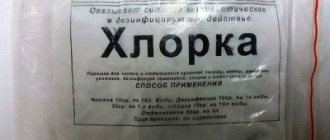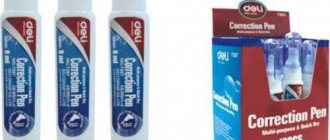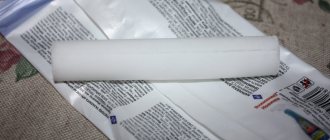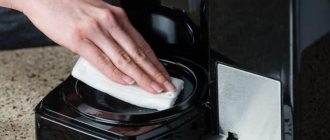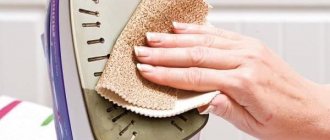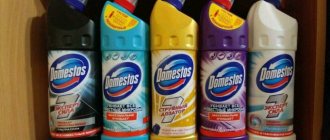Brake cleaner (English definition - brake cleaner) is intended for deep cleaning of metal surfaces from all kinds of contaminants, including process fluids, oil, tar deposits, dust and dirt. The product is used to degrease new brake discs before installation, remove old grease from guides in the brake system, and clean brake pads and other elements of the brake system.
We have compiled a rating of the 10 best brake cleaners, created exclusively on real tests conducted by car enthusiasts and professional craftsmen, as well as positive reviews of the product from specific companies that produce sprays that clean brake parts.
| Product name | Short description | Package volume, ml/mg | Price of one package as of summer 2022, Russian rubles |
| Liqui Moly Schnell-Reiniger | Fast acting cleaner. Can be used to clean components of braking and clutch systems. The test results showed very high effectiveness of the product. | 500 | 400 |
| G-Power | Universal cleaner for brake parts. It has a very powerful spray jet and short drying time. Low price, large volume and high efficiency. | 650 | 180 |
| Wurth | Universal brake system cleaner. Harmless to plastic, rubber, paintwork. During operation, you can turn the aerosol can over. Efficiency is good. | 500 | 300 |
| Berner | Universal brake cleaner. Can also be used for the clutch system. Cleans surfaces very well. Weak, but effective cleaning jet. | 500 | 300 |
| Forch | Brake and clutch cleaner. Has an easily transferable odor. Weak jet propagation. The package includes a spray tube. The effectiveness is average, sometimes you need to apply twice. | 500 | 250 |
| ABRO | Chlorine-free brake cleaner. Quite effectively dissolves contaminants. However, it contains acetone and other harmful substances, so it is very harmful to the human body and can damage rubber and plastic parts. | 397 | 450 |
| Hi Gear | Universal brake cleaner. Dangerous for rubber and plastic parts, as well as paintwork. With its help, you can process elements of the car's electrical system without voltage. Has an unpleasant smell. | 410 | 270 |
| Axiom | Cleaner for brakes and clutch parts. Does not contain acetone or chlorine-containing elements, so it has a tolerable odor. However, it is harmful to the body. Efficiency is average. | 800 ml; 650 ml. | 700; 550. |
| TRW | Average performance brake system cleaner. Often the product needs to be applied two or even three times for old stains. Affordable price is the main advantage. | 500 | 200 |
| Venwell | Cleaner for brakes and clutch system elements. It has low efficiency in dissolving oils and fats, but this is compensated by its low price. | 500 | 150 |
What is brake cleaner used for and how does it work?
During braking, the pads are pressed against the disc with enormous force. In this case, friction occurs with large contact loads. The pad material is softer than the disc metal. Therefore, the pad gradually wears out with the formation of wear products. These wear products partially fall onto the road. But some part settles on the surface of the brake disc and gets clogged into microgrooves.
Modern brake pads are made from a variety of materials: from metal to ceramic. But regardless of the material of manufacture, wear debris that remains on the disc worsens the adhesion force. That is, the effectiveness of the brakes is reduced. The second negative effect is accelerated wear in this friction pair. Fine abrasive particles accelerate wear of both discs and pads.
In parallel, the braking performance is affected by the presence of corrosion. It often happens that after a car sits in a garage for the winter, the wheels become covered with a thin layer of rust. And the first few dozen braking sessions will take place with low efficiency. And subsequently, corrosive dust will fill the microrelief of the disc, which will also negatively affect the braking system.
Brake disc cleaners have two positive effects: they remove contaminants from working surfaces and remove corrosion. And this, in theory, significantly increases the braking force and service life of the pads and discs.
Causes of rust stains
During active use of the car, rust does not appear on the discs, since they are constantly polished while driving.
However, even a short downtime of a few days leads to the formation of corrosion on the metal. This process is especially intense in conditions of high air humidity.
So, the main reason for the formation of rust on brake discs is prolonged idle time of the vehicle. These elements are not protected by anything, therefore, like any other metal parts, they oxidize.
Reviews from motorists and expert opinions
With regular use, all of the above products, as well as their other analogues, will help maintain the efficiency of the braking system at the proper level. That's what auto chemical manufacturers say. What do motorists and service station technicians say? Below we have selected some of the most frequently found reviews about brake cleaners on the Internet.
The conclusion from all of the above can be drawn as follows: brake cleaners really work. And if you want to always use the brake system to the maximum, then a brake disc cleaner will help with this.
Source
What is brake cleaner and why should you have it in your car?
Brake cleaner is designed to degrease and clean brake system elements from various types of contaminants.
Until relatively recently, before the beginning of the 2000s, brakes were cleaned, as a rule, using acetone, which was used to soak a rag or rag.
Today, special agents are used in aerosol cans. With the help of such auto chemicals, not only brake mechanisms are cleaned, but also clutch elements and oily engine housings. After all, all products from this area perfectly remove oil, resins, reagents, metal dust, tar and other pollutants.
Many drivers are convinced that a series of sharp braking ensures sufficient cleaning of the brake discs, and no additional auto chemicals are needed.
In addition, simply braking is not able to eliminate the corrosion on the brake discs that inevitably occurs when the car is idle or operated in a humid climate. Just like dirt, corrosive dust will be actively imprinted into the surface of the disc during sudden braking.
Often, car enthusiasts clean rusted or dirty brake discs or drums with a regular brush or the first cleaner they can get their hands on.
However, by doing so they cause harm to the braking system. After all, during mechanical cleaning, dust is released, which settles on the elements of the brake system. The use of gasoline, kerosene, as well as organic or mineral solvents to clean brakes has an extremely negative effect on the seals and boots of the brake cylinders.
Brake cleaner is also widely used in the repair and maintenance of the brake system. After all, as you know, as a result of the friction of the pads on the disc, metal or ceramic dust is formed, which reduces braking efficiency and also accelerates the wear of the friction pair, acting as an abrasive on both the discs and the pads. It is these clumps of metal dust and shavings that need to be removed by spraying brake cleaner.
After spraying or applying the special product, wipe the brake disc or drum with a rag.
As a result, these elements will become noticeably cleaner, and the characteristic gray coating and rust spots will disappear. After this treatment, when you start moving, you will immediately feel that the braking efficiency has increased. The increase in braking force, depending on the state of the system, can be an impressive 20%!
The aerosol can with the cleaning agent must produce a powerful stream and have the correct spray angle.
In this case, the product will be released under strong pressure, due to which the jet will actually replace a rag or rags, helping to remove contaminants.
The composition of the product must also meet environmental requirements. However, it is no secret that most chemical cleaners are toxic due to the presence of acetone, arbinol heptane, carbon dioxide and toluene. Accordingly, when working with such chemicals, it is necessary to avoid contact of the substance with the skin of the hands and face, as well as with plastic and rubber. You should also choose the least toxic option to purchase.
It would be ideal if you make it a rule to clean the brake system every spring and autumn, that is, when preparing the car for the summer and winter seasons, respectively.
And, by the way, many car owners are not aware that such treatment is usually carried out at a service station during scheduled maintenance or seasonal tire changes.
Source
Folk remedies for cleaning
Folk remedies work no worse than professional cleaners, but are much cheaper. You can deal with rust on wheels using the following compounds:
Lemon acid. It is diluted in warm water. For every 10 liters you will need 50 g of preservative. The disk is completely immersed in the solution and left for 24 hours.
After treatment, the product is washed with a soda solution and then with clean water (read more about removing rust using citric acid here).
Table vinegar. It is used like citric acid. For 10 liters of water you will need 250 ml of vinegar with a concentration of 9%. If the rust layer is thick, then the amount of vinegar is doubled (you can find out more here).
Orthophosphoric acid . It can be purchased at construction stores. The discs are treated with this composition, left for 15 minutes, after which they are washed off with a soda solution and clean water.
Soda slurry. It is convenient to treat small areas of corrosion. The product is prepared in such a way that its consistency resembles sour cream. The paste is applied to the rust, left for an hour, and then removed with a damp cloth.
Sparkling water. To combat metal oxides, you can use Coca-Cola, Sprite or Pepsi. To increase the effectiveness of the procedure, the drink is slightly heated (up to 40 degrees). The disk is completely immersed in Cola and left for a day, after which it is removed, rinsed with clean water and dried.
All of the above products are harmless to metal, so they can be used as often as necessary.
Brake cleaner BOLL
A product with a strong cleansing effect and good penetrating properties. Suitable for disc and drum brakes and all engine oil components. Not harmful to rubber and plastic elements, does not cause corrosion. It even removes dried and stuck-on dirt. Shake the can for 3 minutes before use. Then apply the cleaning agent to the dirty element at a distance of about 20 cm and wait until the product dissolves. Leave to dry or wipe with a dry cloth. If the dirt is so large that the operation did not work, repeat it.
Capacity: from 400 ml. Price: 200 rubles
Cleaning products can also be used for many other tasks often performed in workshops. Prices on average 180 rubles per 500 ml are affordable, so it’s worth purchasing such a product.
Source
Helpful information
To ensure that the cleaning procedure is as effective and safe as possible, you must adhere to the following recommendations:
All work must be carried out outdoors or in a room with good ventilation.- Only plastic or glass containers can be used to soak parts. Metal basins are not suitable for this purpose.
- Blackening of the metal or the liquid in which it is soaked is a normal reaction. It indicates that the cleaning process is active.
- To speed up cleaning, you can heat the solution by lowering a boiler into it. In this case, inhalation of vapors should not be allowed.
- If it was not possible to get rid of rust the first time, repeat the procedure 1-2 more times. If necessary, you can increase the exposure time.
You can learn about methods and methods for removing rust from a car here.
Alternatives to brake lubricants
ATTENTION!
This post was written a long time ago, a lot has changed since then! Latest post via link
Good day to all!
According to the good old tradition, the top question deserves a separate topic)) This time what to replace with what!
1) Lubricant for caliper assembly. Both with and without a handbrake mechanism. I use Ate bremszylinder paste (ATE 03.9902-0501.2) Now it is in the main one under the article 03.9902-0511.2
Yes, it’s not cheap, yes, it’s a horse tube, yes, it’s hard to find...
But this is the best I've tried for these purposes!
THERE IS NO WORTHY ALTERNATIVE! All other options lose in some way. From the alternative from best to worst Febi 31942 TRW PFG 110 Slipkote 220-R Toyota Rubber Grease
2) Lubricant for caliper guides. To lubricate the caliper guides that require lubrication (and that's not all ;)) I use TRW PFG 110
From the alternative from best to worst
Febi 31942 Slipkote 220-R
3) Anti-squeak grease
But here you don’t have to rush! Most of all I liked ATE Plastilube and the most common copper grease! But it is not recommended to use copper on light-alloy calipers.
ATE has only 2 types of lubricants! One for the caliper, more about it above. The second is ATE Plastilube, it is anti-squeak! You can’t use it to lubricate the caliper guides! It comes under 2 codes, the difference is in packaging: 03.9902-1001.2 35ml 03.9902-1002.2 75ml Read the description carefully! ATE Plastilube is an essential lubricant for brake repairs. A special lubricant prevents the brake pads from rusting in the caliper guides and causing brake squealing. To do this, all surfaces of the guides in the caliper, as well as the rear wall of the brake pads, must be lubricated with ATE Plastilube paste before installing the brake.
ATE Plastilube is metal-free and is best suited for use with aluminum brake calipers.
PS Many reputable and not very reputable online stores offer us substitutes for the product we are looking for. Lubricants for the brake system are a complete mess!
The Textar/Pagid Ceratec lubricants offered to you are the same plastic lubricant! So does Bosch Superfit! They are used only as an anti-squeak!
By the way! Superfit also comes in 2 packaging: 5,000,000 150 — 100 ml tube 5,000,000 163 — 200 ml aerosol.
And finally, a screenshot for fans of graphite and other crap...
Last week, a particularly stubborn one said that he always even lubricates the piston with graphite and that this is correct...
Source
Brake cleaners: TOP 5 materials
Brake cleaner is one of the products used in the maintenance and repair of brake system components. Of course, you can use other cleaning products, but they may not cope with the contaminants present on the surfaces of the brake system - lubricants, process fluids, oils, tar deposits, road dirt and reagents.
Many brake cleaners are quite versatile. In addition to their primary purpose, they can be used as a degreaser before preparing for gluing, cold welding or sealing. Using such products, you can clean engine and gearbox parts, throttle valve or carburetor, clutch elements and other surfaces in a car, equipment or household.
Let's look at 5 popular brake cleaners.
Best Brake Cleaners
EFELE CL-546 Spray
EFELE CL-546 Spray
EFELE CL-456 Spray is a brake cleaner based on special solvents, a package of detergent additives and a hydrocarbon propellant. Made in Russia. Has a moderate odor.
The product is intended for cleaning the surfaces of brake system elements from wear products, carbon deposits, tarry and oily deposits. Also suitable for degreasing surfaces before sealing, gluing or cold welding.
It is neutral to rubbers and plastics, evaporates quickly and leaves no residue after use. A powerful spray jet quickly removes contaminants of various nature, including in hard-to-reach places.
The EFELE CL-546 Spray brake cleaner fully meets the above requirements, which allows it to take first place in the review.
Brake cleaner WURTH
Brake cleaner WURTH
WURTH brake cleaner is based on a gasoline solvent. It contains no silicones or adsorbed organic chlorine.
It is used to clean brake system components from soot, dirt, grease and oils, soot, and brake dust. Also suitable for degreasing substrates before gluing.
The spray jet of the product is quite strong, which makes it possible to clean surfaces of dirt without much difficulty.
WURTH brake cleaner, like EFELE, meets these requirements, but it takes longer to remove some types of dirt.
Liqui Moly Bremsen- und Teilereiniger
Liqui Moly Bremsen- und Teilereiniger
Liqui Moly Bremsen- und Teilereiniger brake cleaner is made from solvents that do not contain acetone.
It reliably and easily cleans and degreases surfaces, and also penetrates well into narrow gaps. The product leaves no residue after evaporation and has low surface tension.
The material removes fat and oil stains, tar and tar deposits. In addition to cars, it can be used in industrial equipment.
The characteristics of the Liqui Moly cleaner are similar to previous materials, but its cost is slightly higher.
Motul Brake Clean
Motul Brake Clean
Motul Brake Clean is a brake cleaner without chlorine components.
Declared by the manufacturer as a very powerful degreasing agent. Designed for cleaning brake system parts. Can be used in engine parts, shock absorbers, chain tensioners, etc.
The material copes with oil contaminants, traces of tar and grease, and evaporates very quickly. Has a heavy odor.
The cleaning properties of this cleaner are at an average level, and it can also be aggressive to paints, varnishes, plastics and rubbers, so compatibility testing is required.
VMPAauto brake cleaner
VMPAauto brake cleaner
VMPAauto brake cleaner is made on the basis of aliphatic hydrocarbons. Made in Russia.
It is used to clean the surfaces of brake cylinders, calipers, drums, discs, pads, and ABS components. Suitable for servicing clutch parts, tools and various metal surfaces.
The material has no odor, evaporates quickly and does not leave marks or streaks after use.
The characteristics of this cleaner are average, and to remove some contaminants a large amount of liquid is required.
Rust removal sequence
To keep your brake calipers in tip-top shape, you need to clean the sliding pins regularly. Remove old oil, debris and rust, then add heat-resistant lubricant to the pin and put it back in. The entire process may take about an hour.
Read also: Boiler with pump 220 for a car
The following step-by-step instructions will make cleaning easy:
- Remove the caliper. This is not possible if the car is at ground level, so you will first need to jack up the car. Once it is raised, loosen all the nuts on the four wheels without removing them completely.
- Remove the nuts on the front two wheels.
- Keep the nuts in a safe place.
- Carefully place the film on the surface and cover the cap. This process ensures that most of the vacuum is properly retained in the brake system.
- Loosen the line at the point where it meets the caliper.
- Unscrew it partially and bring the tray to collect the drops.
- Using a screwdriver, remove the spring clip.
- Loosen the bolts and remove them, then remove the caliper from the rotor.
- When it is completely free, you can pull out the pads.
- After removal, use a rubber vacuum cap and pan to collect the liquid. Place a piece of wood between the piston and the outer flange.
- Do-it-yourself cleaning of calipers from rust is carried out using brake fluid to remove contaminants and grease.
- Use a cleaning brush and brake fluid.
- Spray some of the brake cleaner onto the brush and begin processing. Do not spray cleaner directly onto the calipers. The more carefully this step is performed, the better the cleaning effect will be.
- When finished, remove the front locking clip and close the drain valve using masking tape.
- Once it is closed, secure the brake hose fittings as well.
- Take some stiff cardboard and cut out a piece in the shape of an inverted L. You need to protect all parts of the car with plastic film. If paint gets in, the normal functioning of the braking system will be disrupted. You may need to use duct tape to hold the plastic in place.
- Spray the paint onto the caliper using a slow and steady motion. Take special care to prevent paint from getting between the brake pad and rotor.
- Leave the paint to dry before removing the plastic and cardboard.
- Move to the next wheel and repeat the process.
- Make sure the paint is completely dry before attaching the wheels.
- Repeat the process until the caliper is completely clean.
- Observe safety precautions when performing work. Any dust or dirt in the air can get on wet paint. In addition, the smoke from spray paint is dangerous if the driver inhales it, so it is recommended to wear a dust mask when working.
- Replace the piston and reattach the brake line, then install the brake caliper into the wheel. Once all four calipers are serviced and the wheels are installed, check the brakes. If any problems are found, contact customer service.
